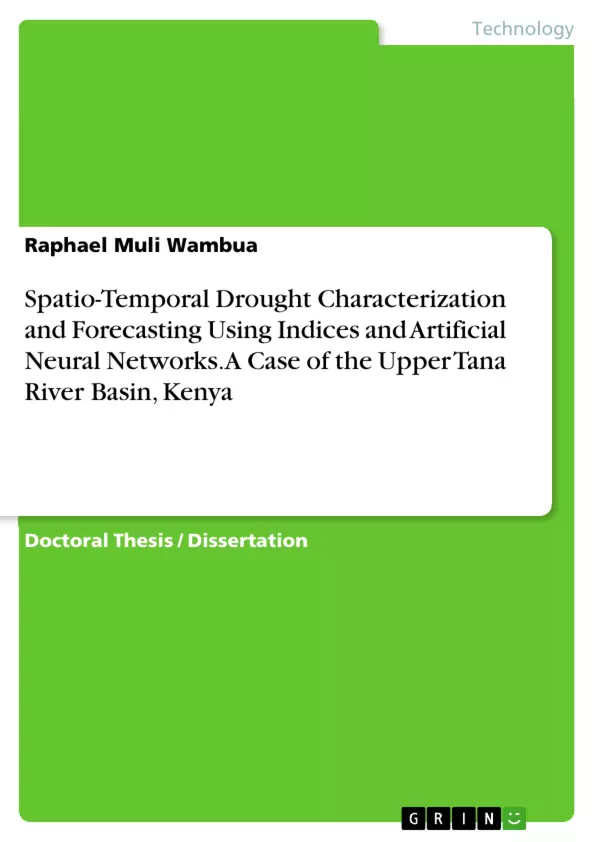Drought is a critical stochastic natural disaster that adversely affects water resources, ecosystems and people. Drought is a condition characterized by scarcity of precipitation and/or water quantity that negatively affects the global, regional and local land-scales. At both global and regional scales, drought frequency and severity have been increasing leading to direct and indirect decline in water resources. Increase in drought severity and frequency in the upper Tana River basin, Kenya, water resources systems have been adversely affected. Timely detection and forecasting of drought is crucial in planning and management of water resources. The main objective of this research was to formulate the most appropriate models for assessment and forecasting of drought using Indices and Artificial Neural Networks (ANNs) for the basin. Hydro-meteorlogical data for the period 1970-2010 at sixteen hydrometric stations was used to test the performance of the indices in forecasting of the future drought at 1, 3, 6, 9, 12, 18 and 24-months lead times, by constructing ANN models with different time delays. Drought conditions at monthly temporal resolution were evaluated using selected drought indices. The occurrence of drought was investigated using non-parametric Man-kendall trend test. Spatial distribution of drought severity was determined using Kriging interpolation techinique. In addition, a standard Nonlinear-Integrated Drought Index (NDI), for drought forecasting in the basin was developed using hydro-meteoroogical data for the river basin. The results of spaial drought show that the south-eastern parts of the basin are more prone to drought risks than the north-western areas. The Mann-Kendall trend test indicates an increasing drought trend in the south-eastern and no trend in north-western areas of the basin. Development of Surface Water Supply Index (SWSI) function, NDI and characteristic curves defining the return period and the probability of different drought magnitudes based on Drought Indices (DIs) was achieved. Drought Severity-Duration-Frequency (SDF) curves were developed. The formulated NDI tool can be adopted for a synchronized assessment and forecasting of all the three operational drought types in the basin. The results can be used in assisting water resources managers for timely detection and forecasting of drought conditions in prioritized planning of drought preparedness and early warning systems.
Inhaltsverzeichnis (Table of Contents)
- CHAPTER ONE: INTRODUCTION
- 1.1 Background
- 1.2 Problem Statement
- 1.3 Research Objectives
- 1.4 Research Questions
- 1.5 Justification of the Study
- 1.6 Scope of the Study
- 1.7 Limitations of the Study
- 1.8 Thesis Organization
- CHAPTER TWO: LITERATURE REVIEW
- 2.1 Drought and its Impacts
- 2.2 Drought Indices
- 2.3 Artificial Neural Networks
- 2.4 Drought Forecasting
- 2.5 Spatial and Temporal Characterization of Drought
- 2.6 Drought Monitoring and Assessment
- 2.7 Applications of Drought Indices
- CHAPTER THREE: MATERIALS AND METHODS
- 3.1 Study Area
- 3.2 Data Sources and Collection
- 3.3 Data Preprocessing and Analysis
- 3.4 Drought Indices Computation
- 3.5 Artificial Neural Network Model Development
- 3.6 Model Training, Validation and Evaluation
- 3.7 Drought Characterization and Forecasting
- CHAPTER FOUR: RESULTS AND DISCUSSION
- 4.1 Spatial and Temporal Drought Characterization
- 4.2 Drought Forecasting Results
- 4.3 Model Evaluation and Performance
- 4.4 Discussion
- CHAPTER FIVE: CONCLUSIONS AND RECOMMENDATIONS
Zielsetzung und Themenschwerpunkte (Objectives and Key Themes)
This thesis aims to investigate the spatio-temporal characterization and forecasting of drought in the Upper Tana River Basin, Kenya, using drought indices and artificial neural networks.
- Drought characterization and forecasting in the Upper Tana River Basin
- Application of drought indices for monitoring and assessment
- Development and evaluation of artificial neural network models for drought forecasting
- Spatial and temporal patterns of drought occurrence and severity
- Contribution to improved drought management and mitigation strategies in the region
Zusammenfassung der Kapitel (Chapter Summaries)
Chapter 1 introduces the research topic, outlines the problem statement, research objectives, and scope of the study. It also highlights the importance of drought research in the Upper Tana River Basin. Chapter 2 provides a comprehensive review of existing literature related to drought, drought indices, artificial neural networks, and drought forecasting methods. It discusses the strengths and limitations of different approaches and identifies research gaps. Chapter 3 details the materials and methods used in the study, including the study area, data sources, data preprocessing techniques, drought index calculations, artificial neural network model development, and evaluation procedures.
Schlüsselwörter (Keywords)
Drought, drought indices, artificial neural networks, forecasting, spatio-temporal characterization, Upper Tana River Basin, Kenya.
- Quote paper
- Raphael Muli Wambua (Author), 2016, Spatio-Temporal Drought Characterization and Forecasting Using Indices and Artificial Neural Networks. A Case of the Upper Tana River Basin, Kenya, Munich, GRIN Verlag, https://www.grin.com/document/458529



